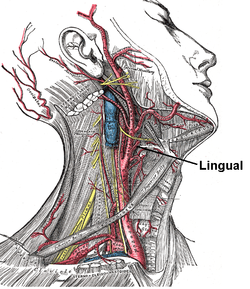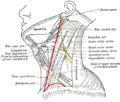Lingual artery
| Lingual artery | |
|---|---|
 Superficial dissection of the right side of the neck, showing the carotid and subclavian arteries. The branch of the lingual artery is labeled | |
 Veins of the tongue. The hypoglossal nerve has been displaced downward in this preparation (lingual artery labeled at center left). | |
| Details | |
| Source | External carotid artery |
| Branches | Sublingual artery Deep lingual artery |
| Vein | Lingual vein |
| Supplies | Genioglossus |
| Identifiers | |
| Latin | arteria lingualis |
| TA98 | A12.2.05.015 |
| TA2 | 4383 |
| FMA | 49526 |
| Anatomical terminology | |
The lingual artery arises from the external carotid between the superior thyroid artery and facial artery. It can be located easily in the tongue.
Structure
It first runs obliquely upward and medialward to the greater cornu of the hyoid bone.
It then curves downward and forward, forming a loop which is crossed by the hypoglossal nerve, and passing beneath the Digastricus and Stylohyoideus it runs horizontally forward, beneath the Hyoglossus, and finally, ascending almost perpendicularly to the tongue, turns forward on its lower surface as far as the tip, under the name of the deep lingual artery (profunda linguae ).
It also supplies palatine tonsil.
Branches
Deep lingual artery
- The deep lingual artery (or ranine artery) is the terminal portion of the lingual artery after the sublingual artery is given off. As seen in the picture, it travels superiorly in a tortuous course along the under (ventral) surface of the tongue, below the Longitudinalis inferior, and above the mucous membrane.
It lies on the lateral side of the Genioglossus, the main large extrinsic tongue muscle, accompanied by the lingual nerve. However, as seen in the picture, the deep lingual artery passes inferior to the hyoglossus (the cut muscle on the bottom) while the lingual nerve (not pictured) passes superior to it (for a comparison, the hypoglossal nerve, pictured, passes superior to the hyoglossus). At the tip of the tongue, it is said to anastomose with the artery of the opposite side, but this is denied by Hyrtl.[citation needed] In the mouth, these vessels are placed one on either side of the frenulum linguæ.
Sublingual artery
The Sublingual Artery arises at the anterior margin of the Hyoglossus, and runs forward between the Genioglossus and Mylohyoideus to the sublingual gland.
It supplies the gland and gives branches to the Mylohyoideus and neighboring muscles, and to the mucous membrane of the mouth and gums.
One branch runs behind the alveolar process of the mandible in the substance of the gum to anastomose with a similar artery from the other side; another pierces the Mylohyoideus and anastomoses with the submental branch of the facial artery.
Other branches
- The suprahyoid branch of the lingual artery runs along the upper border of the hyoid bone, supplying oxygenated blood to the muscles attached to it and anastomosing with its fellow of the opposite side.
- The dorsal lingual branches of lingual artery consist usually of two or three small branches which arise beneath the Hyoglossus. They ascend to the back part of the dorsum of the tongue, and supply the mucous membrane in this situation, the glossopalatine arch, the tonsil, soft palate, and epiglottis; anastomosing with the vessels of the opposite side.
Additional images
-
Diagram showing the origins of the main branches of the carotid arteries.
-
The internal carotid and vertebral arteries. Right side.
-
Coronal section of tongue, showing intrinsic muscles.
-
Side of neck, showing chief surface markings.
-
Lingual artery
-
Lingual artery
-
Lingual artery
-
Lingual artery
References
![]() This article incorporates text in the public domain from page 553 of the 20th edition of Gray's Anatomy (1918)
This article incorporates text in the public domain from page 553 of the 20th edition of Gray's Anatomy (1918)
External links
- Radiology image: Headneck:15Commo from Radiology Atlas at SUNY Downstate Medical Center (need to enable Java)
- Anatomy photo:25:14-0102 at the SUNY Downstate Medical Center
- Branches at University of Oklahoma








